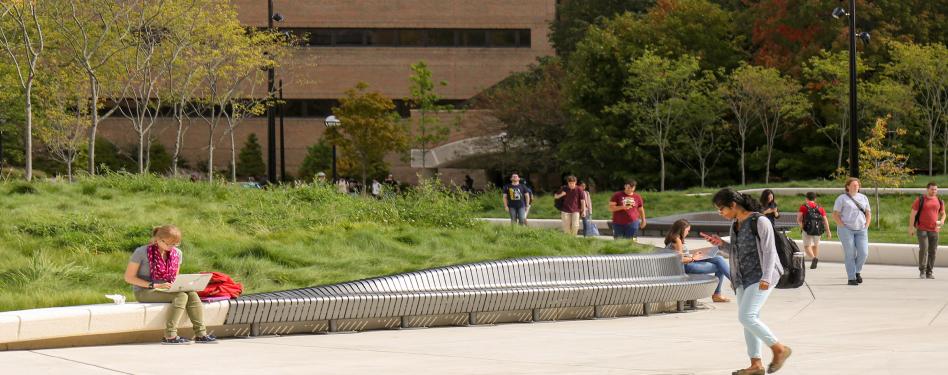
Feature image: The University of Michigan Gerstacker Grove project. Image courtesy of Landscape Forms.
Amy Syverson-Shaffer, SITES AP, ASLA, RLA, is a trained landscape architect and sustainability leader at Landscape Forms, a North American designer and manufacturer of high-design outdoor furniture, structures, LED lighting and accessories. The company is based in Kalamazoo, Michigan.
Syverson-Shaffer brings a passion for sustainable outdoor design as well as landscape architecture expertise to the furniture manufacturing company, which is currently seeking new strategies to reduce its environmental impact. SITES has been a key tool in helping Landscape Forms visualize where its products best align with the evolving landscape design and development field.
“Landscape architects are starting to think about landscapes in a more intentional way,” noted Syverson-Shaffer. “We want to be aligned with them to create solutions that are better than ‘business as usual.’ We use the SITES rating system as a best practice manual for land design and development; we want to support those best practices.”
As a SITES AP, Syverson-Shaffer considers the bigger picture of the company's products in the context of land development projects.
Becoming a SITES AP
Syverson-Shaffer discovered SITES during her postsecondary education, thanks to the ecological restoration focus within the School of Environmental Design at Temple University, where she earned her bachelor's of science degree in landscape architecture. Her education kick-started a career dedicated to the intersection of these two things—ecological restoration and landscape architecture—as well as the tools that facilitate this, such as SITES.
When it became clear that the SITES rating system would be an ongoing reference point for her work at Landscape Forms as sustainability leader, Syverson-Shaffer decided to pursue her SITES AP credential.
Administered by GBCI, the SITES AP credential establishes a common framework to define an individual's knowledge in creating sustainable and resilient landscapes and other outdoor spaces. SITES APs demonstrate the skills necessary to support the SITES certification process, including participating in the design and development process, supporting and encouraging an integrative design process, and managing the application and certification process.
Studying for the credential helped Syverson-Shaffer gain perspective on the less tangible elements of landscape design and development—elements she described as “things that fly under the radar that aren’t about the product but about the bigger picture"—to complement her existing expertise. This expanded context included operations and maintenance requirements, site boundaries, supply chain impacts, and the benefits of different strategies and choices when considered together as part of a holistic plan.
“It also made me think more about the impact our products have on the environment, which often happens further up the supply chain, where we don’t see them,” explained Syverson-Shaffer. “Material credits are really helpful in understanding where we can lessen that impact.”

The University of Michigan Gerstacker Grove project. Image courtesy of Landscape Forms.
Additional ways to use SITES
Landscape Forms is a SITES Community Partner, an organization publicly committed to prioritizing meaningful, high-performance outdoor spaces and following SITES’ guiding principles. As part of that commitment, the company recently released a SITES Specification and Documentation Guide. This resource outlines the documentation needed for SITES projects to potentially achieve points toward credits in the rating system.
“We know that the customers pursuing SITES certification represent the top of the field, and they’re doing important work in the same communities we’re in,” Syverson-Shaffer explained. “Certification can be a heavy lift because it represents the highest levels of achievement. To support that, we wanted to create a practical guide that makes our customers’ work a little easier as they are trying to be the best of the best.”
Manufacturing more sustainable landscape products
While the manufacturing industry is working on understanding and improving its environmental impact, Syverson-Shaffer pointed out that much of the existing research has been on interior materials, rather than those meant for outdoor spaces.
“The requirements [for outdoor materials] are different, and the manufacturers supplying outdoor projects tend to be smaller,” she noted. “There’s less data, so we don’t have much of a baseline yet. Still, we’re working on building up these material metrics in order to lessen their impact on climate and biodiversity.”
Syverson-Shaffer and the Landscape Forms team are aware that, as manufacturers, they are tasked with understanding and planning for what they want the future to look like, because it’s a future their customers will amplify—intentionally or otherwise. As she and her colleagues learn how to improve the intrinsic sustainability of their products, Syverson-Shaffer is carefully aligning her work with existing tools, including the SITES rating system.
“It’s hard to overstate the importance of SITES for this field," she said. "It is so holistic. That helps us see what we need to do without recreating everything ourselves. Looking at what we want to do next, we’re digging deeply into SITES because a lot of the strategies are already in there. It’s a great jumping-off place."
